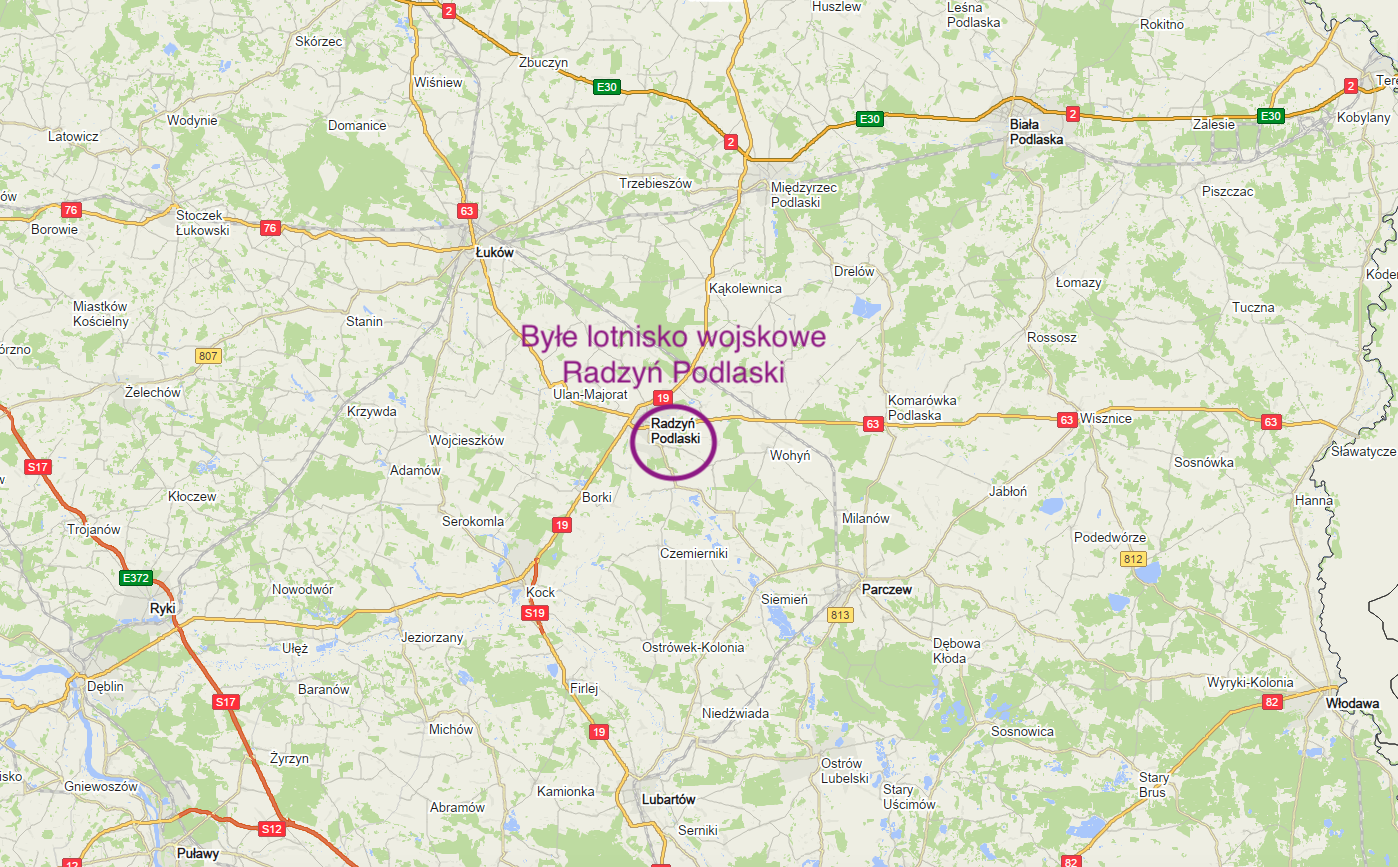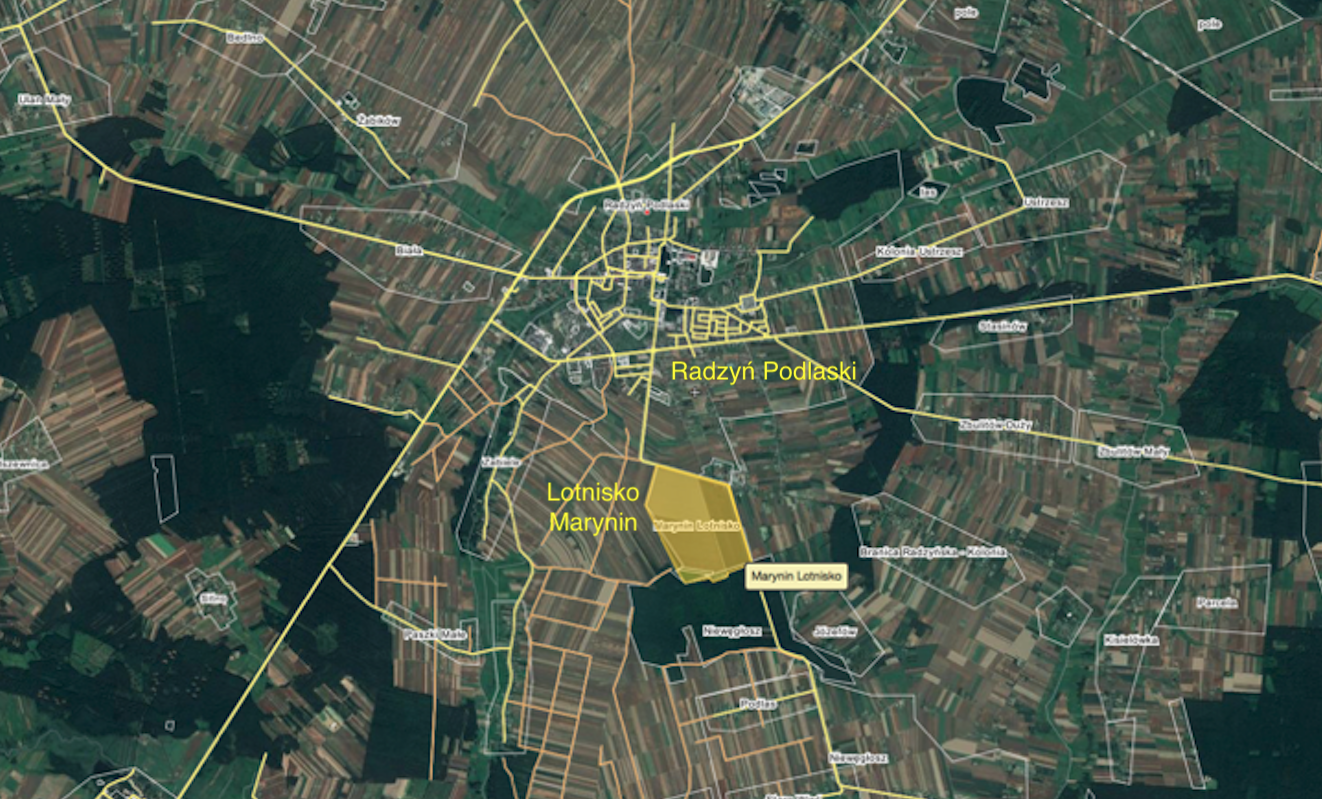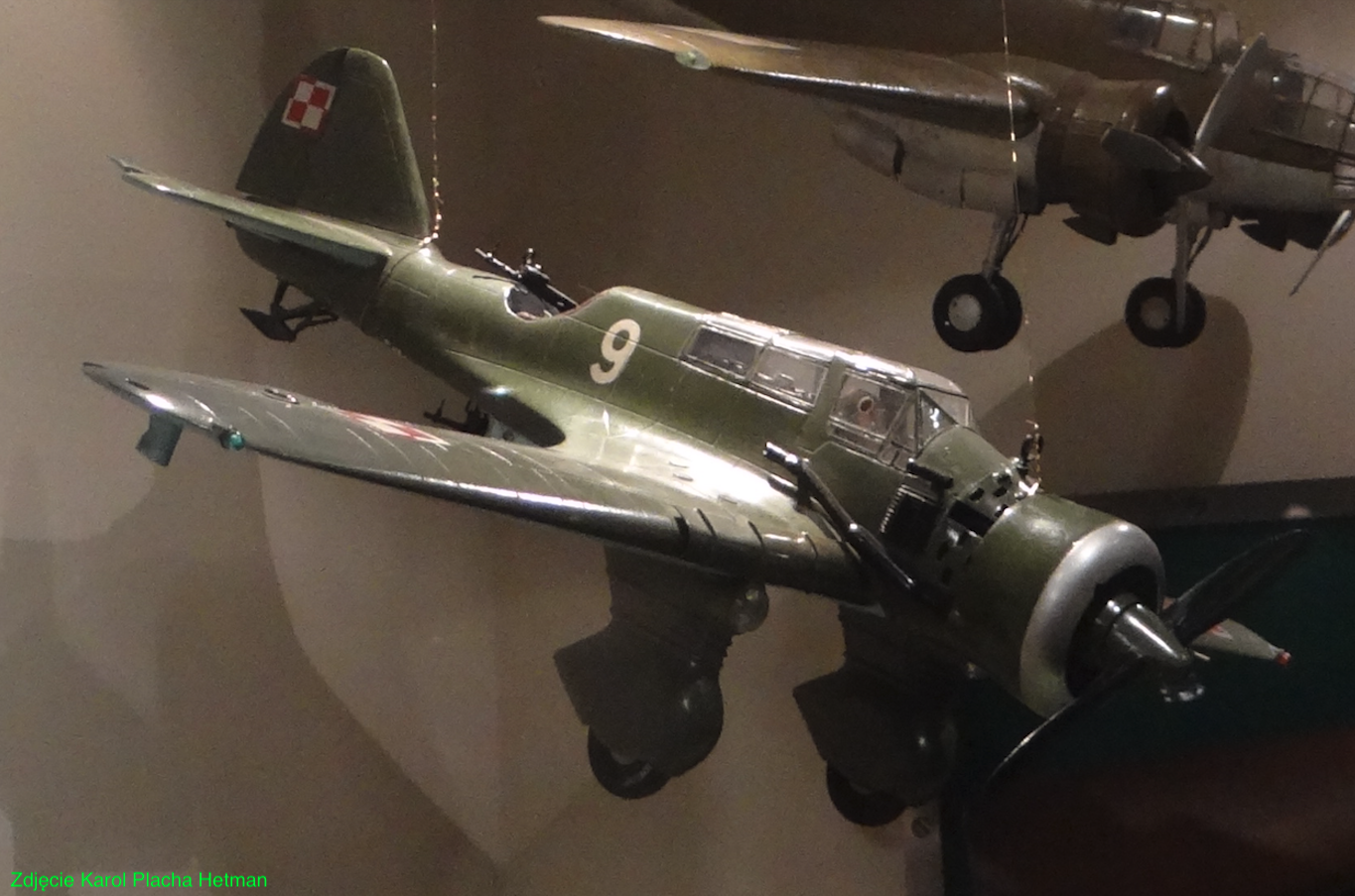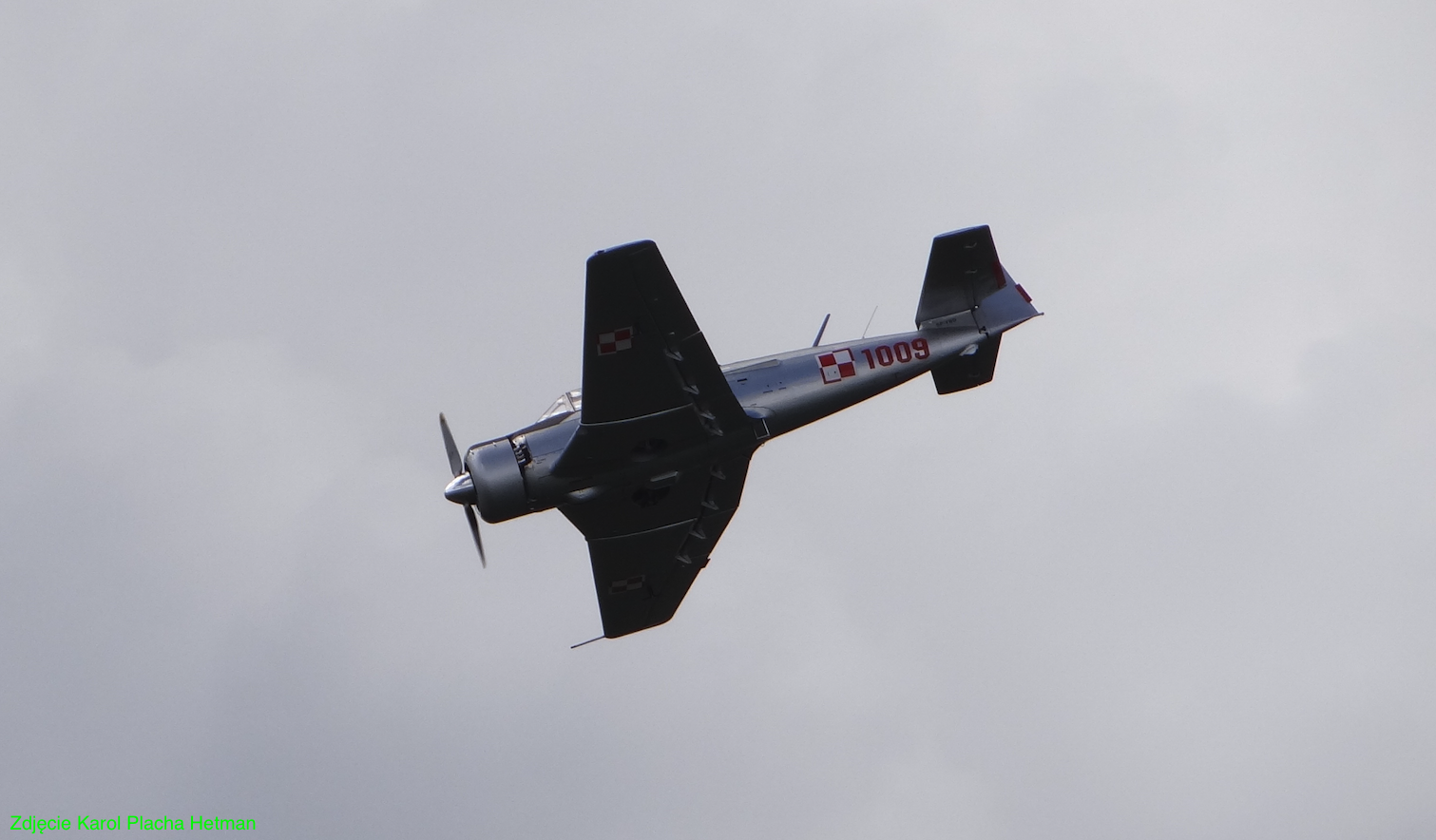Radzyń Podlaski 2017-12-10
Radzyń Podlaski Airport. Marynin Airport.
Geographic coordinates: 51.747N 22.631E. Elevation 158 m.
Radzyń Podlaski is a city in the Lublin Voivodeship, in Radzyń County. In 2017, the city had approximately 16,400 inhabitants.
Radzyń Podlaski is located in the Łukowska Region, approximately 70 km north of Lublin and approximately 70 km south-west of Biała Podlaska. In the years 1975-1998 Radzyń Podlaski belonged to the Bialskopodlaskie Voivodeship. The Białka River flows through Radzyń. The average height above sea level is 140-160 m. The inhabitants of the commune earn their living mainly from agriculture. The area of the city is 19.29 km 2. The city constitutes 2% of the county’s area.
National Road No. 19 (running longitudinally through the Podlaskie, Masovian, Lubelskie and Podkarpackie Voivodeships) and National Road No. 63 (running through the Warmian-Masurian, Podlaskie, Masovian and Lubelskie Voivodeships) run through Radzyń Podlaski. Provincial Road No. 814 runs next to the Marynin Airport (connecting Radzyń Podlaski with Glinny Stok).
Radzyń Podlaski – history.
Until the end of the 14th century, these areas were not very suitable for permanent settlement because they were located at the border of Poland, Lithuania and Ruthenia. It was only during the reign of Władysław Jagiełło that the situation changed and settlers from Lesser Poland and Mazovia gradually began to arrive in these areas. The first settlements date back to 1380-1390. Parishes began to be established then, and the first wooden churches were built along with them. Initially, the settlement, in the place of today’s City, was called Kozietule, due to the goat trade developing here, for which a market was organized. The original name Radzyn appeared around 1450. Over time, the name softened and was pronounced Radzyń. The settlement was almost called Kozi Rynek. In 1468, the settlement of Radzyń received city rights under Western Law from King Casimir IV Jagiellon and was royal property. In the mid-15th century, an Orthodox parish was established in Radzyń and an Orthodox church was built. The first brick Roman Catholic church was completed in 1641 and consecrated in 1644.
The development of the city was hampered by numerous wars and army marches. In 1741, the town of Radzyń Podlaski became the property of the Potocki family, who built an impressive palace here. At the end of the 19th century, a railway line from Lublin to Łuków was run through Radzyń Podlaski. The first school in Radzyń was established in 1915 during the Great World War. First there was a junior high school, and in 1917 a high school. After Poland regained independence, the owners of the city, the Szlubowski family, handed over the destroyed Potocki palace to the state. The palace was renovated and became the seat of the region’s authorities. During the Second Polish Republic, the city still had wooden buildings. There were few brick houses. After a large fire in 1930, the city received most of the two-story brick houses.
The Germans bombed the city on September 9, 1939, when the streets were blocked with thousands of Polish refugees. The Swabians appeared in Radzyń Podlaski only after the famous Battle of Kock. The resistance movement against the occupier was organized in October 1939. The first troops were composed of scouts and adults. The first execution by the Germans on the Polish population took place in a nearby forest on July 5, 1940. More than 100 towns in the district were places of mass executions. As a result of the occupier’s repressive actions, over 24,000 inhabitants of the district died.
During the Germanic occupation, Radzyń Podlaski became one of the places of concentration of German troops to attack CCCP. In particular, the railway station and surrounding buildings became warehouses for weapons and military supplies.
In 1944, in the Radzyń Land, there were already 4,200 Home Army and NSZ soldiers. They were subordinated to the Lublin District of the Home Army.
While retreating, the Germans set fire to the Potocki palace, and the fire led to its enormous destruction. On July 23, 1944, Radzyń Podlaski was "liberated" by Soviet troops and Home Army soldiers. And a new occupation began.
The Potocki Palace was repaired to the best of the abilities of the local authorities. It became the seat of numerous institutions that only carried out current renovations. Nevertheless, it fell into ruin. In 1980, systematic renovation works began. The Foundation for the Protection of the Palace and Park Complex in Radzyń Podlaski was established. Radzyń’s cultural institutions are located in the renovated palace rooms.
Marynin Airport, Radzyń Podlaski.
The airport in Radzyń Podlaski was established during the Second Polish Republic. In 1935, the Polish Army Staff designated several places for field airports. One of them was the airport near Radzyń Podlaski in Marynin.
It was a typical field airport, often used during military and air exercises. In the 1930s, Marynin Airport was often used by bomber squadrons. Among others, by the 55th Bomb Squadron of the 5th Aviation Regiment (Lida), which operated Karaś aircraft.
The Germans occupied Radzyń on October 7, 1939, by the 213th Infantry Division of the 8th Army of General J. Blaskowitz. He established a Military Board in the city. In June 1941, Marynin Airport was reopened. They were occupied by Luftwaffe units, as well as units of H. Guderian’s 2nd armored group of the 9th Army "Centre" and the "Gross Deutschland" infantry regiment (from XIII Tank Corps). Operation Barbarossa was being prepared. From the fall of 1943, the 3rd battalion was stationed here. 25th SS Police Regiment (Radzyń), airport security units and units protecting Wehrmacht facilities.
Probably during the occupation or at the end of the 1940s, a railway siding was added to the Marynin Airport. It was used to supply the MPS depot with fuel for aircraft.
During the occupation, the Germans expanded the airport slightly. First of all, they built a concrete taxiway in the adjacent forest. They built plane stands along this road, well hidden from air reconnaissance. They also expanded the fuel depot and ammunition warehouse (bomb depot). They built several underground hiding places. SKG 210 equipped with Bf-110 aircraft and III/KG 53 with He-111 aircraft were stationed in Marynin. After the front passed, Marynin Airport was taken over by the Russians, who used it periodically until around 1949.
Polish planes appeared in Marynin between 1951 and 1953 and they were both training and combat planes. Among the combat ones were the Ilyushin Il-2 and Ilyushin Il-10. The airport was planned to be significantly expanded.
For 50 years, the Marynin Airport was the place of temporary stationing of the 59th Aviation Training and Combat Regiment of the OSL in Dęblin.
In 1959, Marynin Airport was designated as the basic airport for the newly established training regiment subordinated to the Officer School in Dęblin. It was the 52nd Aviation Training Regiment. Its inventory included TS-8 Bies and Yak-11 aircraft. Pilot Major Stefan Czarnecki, who was promoted to the rank of lieutenant colonel, was appointed commander of the Regiment.
The 52nd Aviation Training Regiment was established on the basis of the 24th Reserve Pilot Training Squadron in Ułęż and the 25th Reserve Pilot Training Squadron in Podlodów. Job No. 20/454. The Regiment consisted of two Squadrons.
In April 1959, the 52nd Aviation Training Regiment was transferred to the Oleśnica Airport, but already in June 1959, the Regiment returned to the Ułęż and Podlodów Airports.
On July 13, 1960, the 2nd Squadron of the 52nd Aviation Training Regiment, commanded by Capt. pil. Ryszard Mierzwiński was assigned to OSL im. Żwirki i Wigury in Radom. The 52nd Aviation Training Regiment included a Training Squadron based at the Airport in Radzyń Podlaski, commanded by Major Pil. Zygmunt Mazurek.
In 1961, the Full-time Regiment No. 20/506 was reorganized, with 563 soldiers and 17 civilian employees. On October 2, 1961, the 52nd Aviation Training Regiment received the banner.
In 1962, the 52nd Aviation Training Regiment was disbanded. Due to the reorganization of officer aviation schools, the Chief Aviation Inspector, by September 30, 1962, disbanded the 52nd Training Regiment of the Officer Aviation School. Jan Krasicki. His one squadron from Radzyń Podlaski became the nucleus of the 47th Liaison and Sanitary Aviation Regiment in Modlin. The training planes finally left the Marynin Airport in 1963.
At that time, plans to expand Marynin Airport were completely abandoned. Its main element was to be a new, hardened (concrete) runway (DS., RWY). It was also planned to develop a radar navigation system.
The barracks in Radzymin Podlaski were occupied by the 57th OTK Renovation and Construction Battalion (Unit 2899). The 84th Civil Defense Department and the Military Service and Production Plant were also located here. The Military Unit was stationed here until around 1991.
In 1995, the barracks and other buildings were occupied by the Labor Corps, and currently it is the Training and Upbringing Center. The former barracks building was completely rebuilt.
Around 1995, Marynin Airport was transferred to the Military Property Agency. In its heyday, the flight field had dimensions of approximately 1,400 m x 1,000 m and an area of approximately 140 hectares. This includes the entire Niewęgłowz forest complex. In 2000, Marynin Airport was put up for sale. Currently (2018), on a significantly reduced area, Marynin Airport is privately owned and has the status of an airstrip.
The forest near the Airport is still dangerous due to numerous unexploded bombs (old terminology) and unexploded bombs (new terminology). The ammunition is Polish (defensive war), Germanic (occupation) and Soviet remnants. Sappers come to eliminate unexploded ordnance only after finding and reporting it. The forest was never completely cleared. According to residents, several people have already died from unexploded ordnance. The easiest places to find are air bombs, air cannon ammunition and grenades. The last confirmed finding of World War II aircraft bombs took place on September 3, 2016. There were three bombs weighing about one kilogram each. The police appeal for caution and remind that found unexploded ordnance should not be touched or attempted to be moved. It is also important to protect the place against accidental access by people unaware of the threats until the arrival of the appropriate services. The forest also became a place for waste disposal for local residents. You can also find traces of the activities of the Polish Army from the 1970s and 1980s.
Basic data – Marynin Airport, Radzyń Podlaski.
Private landing pad. Geographic coordinates 51°45’35"N 22°37’58"E. Elevation 150 m above sea level 470 ft. RWY 098/278, 390 x 30 m, N51°44’53.2" E22°37’45.6". Contact tel. +48 604445375.
Comments – Private landing strip on the site of a former military airport. In zone TSA04A. Leveled, rolled, mown. Place to pitch a tent, access to water. The power line and utility pole seen in older photos have been removed and no longer constitute an obstruction on approach 28.
Written by Karol Placha Hetman




